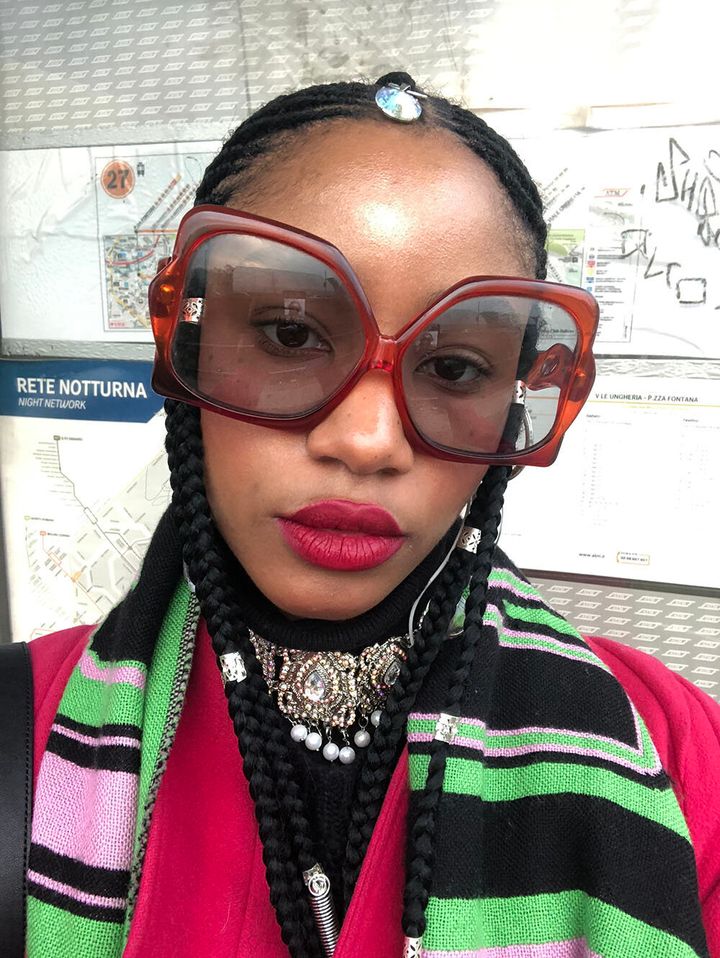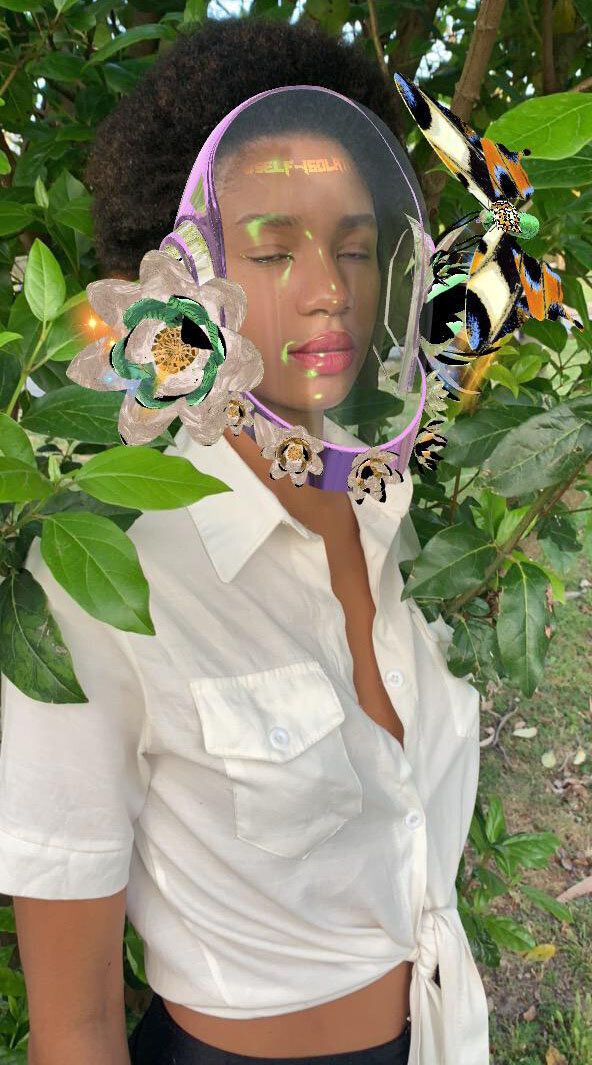Damara Inglês is, without a doubt, one of the most exciting voices in fashion today. The Angola-born, globally based, self-proclaimed “fashion tech cyborg” is a graduate of the London College of Fashion, UAL, and a winner of the Kering Award for Sustainable Fashion 2019.

Damara doesn’t call herself a designer; rather, she’s a “fashion media practitioner and curator of extended-reality and interactive experiences” who’s worked across design, styling, theatrical wardrobe and fashion writing, all of which has influenced her creative work today.
Damara’s work has always focused on the interplay between our physical bodies and our digital identities, a concept she’s exploring further in her latest project, The Fabric of Reality, an immersive virtual fashion show experience unlike any we’ve imagined before, presented by Verizon Media’s in-house creative studio, RYOT. Damara is participating in the project alongside other boundary-pushing designers, Sabinna and Charli Cohen.
For The Fabric of Reality, Damara teamed up with Australian artist and interactive designer Stuart Campbell, aka Sutu, to create a bio-technologically inspired story world, where elements of nature exist around the garment, which becomes a morphing hybrid.
“My first starting point was the notion that astronauts wear helmets and suits, scuba divers wear protective suits and oxygen tanks… what will we wear to explore this new stage of humanity and this new ambiguity?” Damara tells us in a phone interview, when asked about her inspiration for this project.
Damara also looked to the various underwater species that have been discovered in recent years living in the dark recesses of the water, like the Mariana snailfish, which survived against all odds at a depth of 8,000m underwater.
“I used the analogy of a new species and the deep ocean of water as a portal between the physical and the digital,” explains Damara. In The Fabric of Reality, her virtual storyworld features falling drops of water and sound bubbles to bring this underwater theme to life.
Damara also describes her virtual fashion concept as “an analogy of the underworld,” saying:
“I’m very obsessed with Greek and Roman mythology and my interaction with technology and with the internet is based on this Neo-mythical ideal that technology can save us and start a new era of debate and vocabulary.
“The virtual world is the underworld, the world of shadows. To enter you have to encounter this three-headed dog that is protecting the gate. This is the first ever hyper-immersive show, and it’s beautiful to have such an antique reference and to use it as an analogy for new issues and new solutions.”
The Cerberus of Hades figure will be replaced by a sculptural garment, created with multiple face filters - another topic Damara likes to explore in her work.
Face filters can make us feel protected, but also vulnerable - if a face filter puts a virtual spider or a worm on our face, we’ll try to remove it from our physical selves. In Damara’s view, filters perfectly encapsulate that relationship between the human physical and the digital self. Will augmented reality filters protect protestors one day?

“It’s really weird and complex to understand that connection between the physical body and necessity, and anxieties with digital solutions,” says Damara.
Damara has incorporated aspects from her past work in technology into this new project, like her Kintsugi meditation project with Somerset House Studios, where she created a VR wellness room with constantly changing environments, as well as her “Vintage Ghost” project, which used VR and AR to question what connections she had with people who owned her vintage garments before she’d bought them. Working with Sutu for this project, the team used Tilt Brush software - a tool Damara describes as incredibly “democratic.”
“Normally when I’m working in 3D designs, I feel like the computer is my employee and I’m giving orders. With Google Tilt Brush, I felt like the computer and I were at the same level - we were responding to each other’s limitations and it was the perfect tool to develop this project about tensions between the physical analog body and the virtual,” says Damara.
Damara not only likes the sustainable potential that virtual fashion affords - her Kering-Award winning project used AR to transform the basic T-shirt from a throwaway item to a sustainable, extended-reality garment that can constantly be updated in the virtual sphere - but is also a fan of the democratising potential of fashion technologies, which can turn anyone into a creator.
“Imagine fashion that isn’t based on the privilege of being able to obtain a degree from a fashion university? It’s more inclusive to the consumer, too - mass-produced capitalist fashion narratives are very limiting. Mixing traditional fashion with technology that’s always looking for new forms of hope and expectation, what kind of voices will be exalted? What kind of narratives will we focus on?” she asks.
Damara likes the endless creativity available to her when working in the virtual sphere. Physical fashion isn’t without its limits: you need to respond to trends and materials according to the season since physicality is dependent on weather, and it has to serve a purpose (to keep us warm, to protect us).
Virtual fashion changes the priorities - the shape of a garment doesn’t have to fit a human body or serve a particular need, let alone look beautiful on the body. Designers get the opportunity to pioneer something entirely new, like a sense of tactility without touch, while viewers are invited to experience new sensations.
For Damara, this hyper-immersive fashion show experience is an opportunity to change how people perceive fashion as clothing and fashion as identity, one she hopes will leave viewers questioning contemporary fashion constructs and pushing them to connect to fashion in a new way.
Perhaps they’ll be courageous enough to experiment with their style, or they’ll feel a different emotional connection with clothes so they don’t need to buy so many disposable garments. They may even learn to appreciate the value of fashion as a self-generating, constantly evolving phenomenon.
Damara also wants viewers to think about how fashion can evolve to cater to the reality of living between the physical and the digital, to respond to the issues of the day, like how augmented-reality fashion will help us to maintain a minimal distance in a post COVID-19 world. That interplay between our vulnerable biological bodies and the virtual stage won’t just be a theme in Damara’s art in the not-too-distant future, it will directly impact all of our realities.
“I want viewers to leave this experience feeling like ‘this is the best outfit I ever wore’ - without ever wearing it,” says Damara.